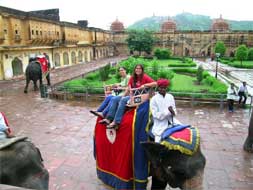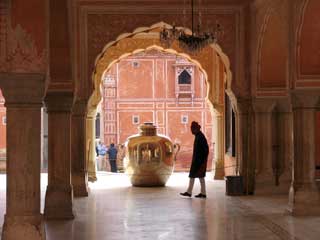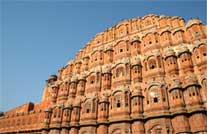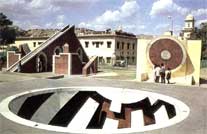|
Home >>
Destination Guide India > Jaipur
DESTINATION
GUIDE INDIA - JAIPUR
ABOUT JAIPUR CITY
JAIPUR -The
City of Victory - was originally Sawai Jaipur, named after
its founder Sawai Jai Singh II (1700-1743). It epitomises the
dreams of the visionary Kachhwaha ruler, who wanted to build a
new and planned capital city; and the creative ideas of his
talented designer-builder Vidyadhar .
In course of
time the sunset-pink tinge of its walls, buildings, temples
and emporia gave it the name Pink City, the name in which it
became famous throughout the world.
Jaipur was
built by Vidyadhar in a grid system with wide straight
avenues, roads, streets and lanes and uniform rows of shops on
either side of the main bazars, all arranged in nine
rectangular city sectors (chokris). The city itself is an
attractive creation worthy of universal admiration.
The principal
monuments of Jaipur are concentrated in the centrally situated
palace sector (Chokri Sarhad) in and around the City Palace.
TOURIST
ATTRACTIONS - JAIPUR CITY
»
Amer Fort
The
Kachchawahas ruled from Amber, 11 km from Jaipur, for seven
centuries. With a history so old, it is not unexpected that
there is a lot of the past that can be traced in its
archaeological history. While many of the early structures
have either disappeared or ruined, those dating from the16th
century on are in a remarkable state of preservation. Amber as
it exists now is the handiwork of three of the kingdom's
rulers that include Man Singh, and Jai Singh I and II.
Approached from a steep ramp, visitors ride up on elephant
back, entering through the grand Singh Pol gateway and
continuing to Jaleb Chowk, the courtyard where they disembark
from the pachyderm. From here, they are faced wit two flights
of steps, one leading to Shila Mata complex with its enshrined
image of the goddess, and the other to the main palace
complex.
Within the complex, Ganesh Pol, an imposing gateway painted
with images of the elephant-headed god, Ganesh, takes pride of
the place. Also a part of the complex is the Diwan-i-Am or
hall of the public audience with its spectacular display of
pillars. The typical merging of Rajput and Mughal
architectural styles is captured in the Sukh Nivas and Jas
Mandir apartments, and the Charbagh garden with its perfectly
proportioned landscaping. A highlight is the pierced screen
windows which offer views form points of vantage, as well as
the shimmering mirrors encrusting the walls of the Sheesh
Mahal. Several other gardens and pavilions within the
sprawling spread of ramparts offer enough scope for
investigating medieval lifestyles at leisure.
Beyond the ramparts, the old city, once the abode of the
aristocracy, has a wonderfully medieval flavor, though it has
few buildings of majestic proportion that are still extant.
However, a walk through the rambling lanes will reap rich
rewards for the curious besides a large number of temples
there are also step-wells, memorials and town houses.
»
City Palace
Sawai Jai
Singh's seven-storey high Chandra Mahal -Moon Palace -has come
to be known as City Palace to differentiate it from the
ancient Amer Palace and the neo-modern Rambagh Palace, the hub
of activity of the last ruler. The former ruling family still
lives in the Chandra Mahal, while the outer courtyards with
Mubarak Mahal, Sarvatobhadra and Diwan Khana and the ground
floor halls of Pritam Niwas and the inner courtyard have been
converted into a public museum - the Maharaja Sawai Man Singh
II Museum.
It houses an
extensive collection of rare manuscripts, Mughal and
Rajasthani miniatures, Mughal carpets, costumes and textiles,
arms and weapons, objets d' art and royal paraphernalia. The
pair of giant silver Gangajalis displayed in the open
Sarvatobhadra building were fabricated in the court workshops
for Sawai Madho Singh II to carry holy water of Ganges to
England. These find mention in the Guinness Book of World
Records as the largest silver objects in the world.
»
Hawa Mahal - Palace of Winds
Built by the
orders of poet-king Sawai Pratap Singh, the Hawa Mahal is the
most strikingly designed monument in Jaipur. What is seen from
the Sireh Deorhi Bazar is the multi-niched five-storey high
back-side of the complex. It was conceived to provide adequate
vantage position behind delicate stone-carved Jali screens to
the palace women for watching the royal processions passing
through the bazar below.
»
Ram Niwas Bagh
To provide open
space and greenery to the citizens, this large garden with a
zoo, an aviary, a greenhouse, a herbarium, a museum and
several sports grounds was built during the reign of Sawai Ram
Singh II in 1868 as a famine relief project. The beautiful
Indo-Saracenic structure of the Albert Hall designed by Sir
Swinton Jacob was opened in 1887 as a public museum. It
contains a fine collection of sculptures, paintings,
decorative art objects, natural history specimens, an Egyptian
mummy and the celebrated Persian Garden Carpet. Recently the
Rabindra Manch with an auditorium, a modem art gallery and an
open-air theatre has been added to promote cultural
activities.
»
Jantar Mantar - Observatory
Just outside
the gateway of the City Palace is Jantar Mantar, the
Yantralaya of Sawai Jai Singh II, the last great classical
astronomer in India. The modernistic structures known as
Yantras are the unique creations of this astronomer-king
designed by him and built by experts to observe the movements
of sun, moon, planets and the stars. This is the largest of
five observatories founded by him in various parts of the
country.
»
Govind Devji Temple
In the central
pavilion of the sprawling Jai Niwas Garden to the north of the
Chandra Mahal is the spireless temple of Lord Krishna. The
image in the form of Govinda Deva, originally installed in a
temple of Vrindavan, was reinstalled here by Sawai Jai Singh
II as his family deity. This is the most famous and popular
temple in the Pink City attracting devotees from allover the
country.
HOW TO REACH
»
Air : There are flight
connections to Delhi, Kota, Jodhpur, Udaipur, Aurangabad,
Bombay and Ahmedabad.
» Rail : An excellent connection from Delhi
is Shatabdi Express which provides a fast, air-conditioned of
vestibuled, rail service. Other connections to Jaipur are from
Bikaner, Jodhpur, Udaipur, Ahmedabad, Secunderabad, Agra,
Lucknow, Bombay and Calcutta. There is also a special luxury
train, the Palace on Wheels, which starts from Delhi on
a round trip of Rajasthan, firt stop being of Jaipur
»
Road : A convenient
mode of travel of Jaipur is by road, Some distances of note
are : Delhi 261 km, Udaipur 405 km, Jodhpur 336 km, Ahmedabad
657 km.
|
![]()